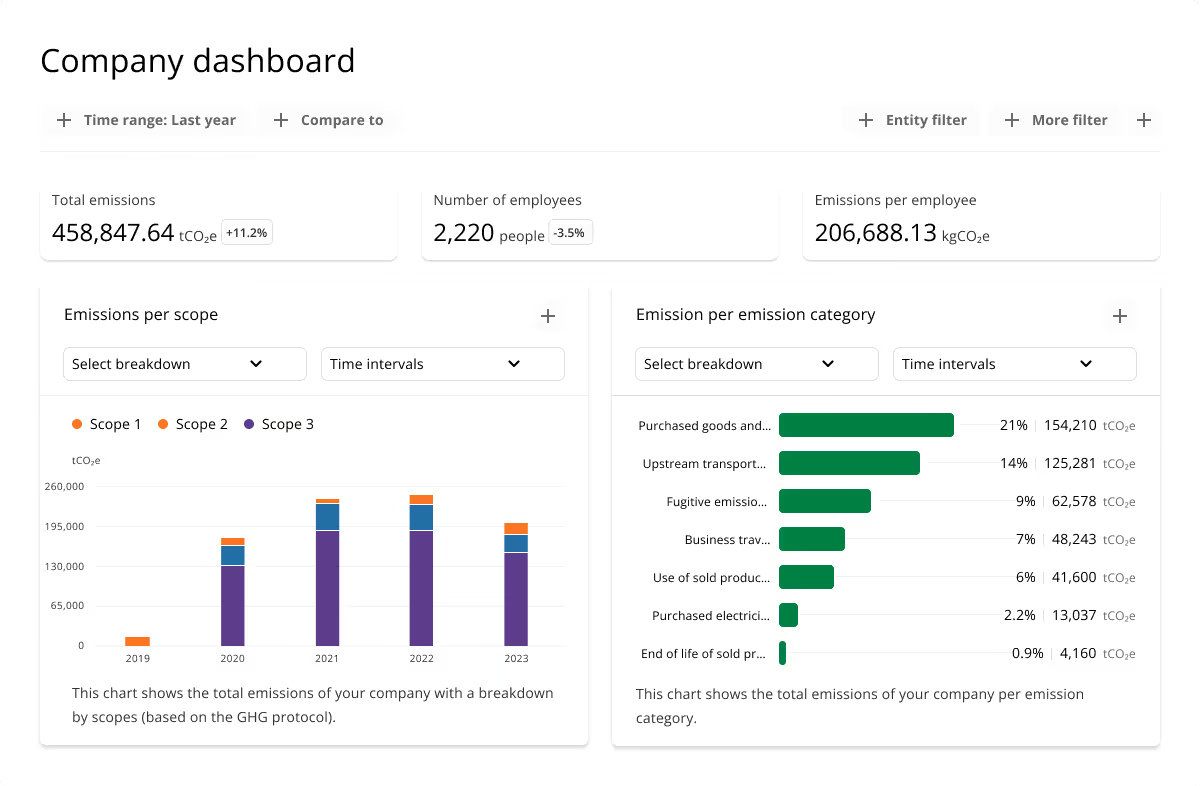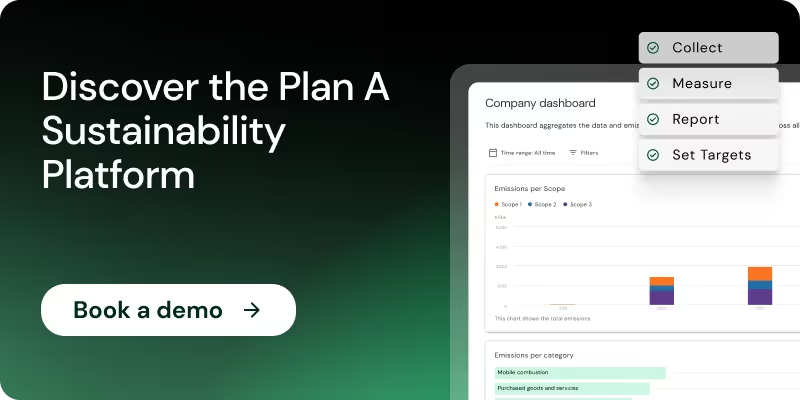The corporate sustainability landscape is evolving at an ever-so-rapid pace. Accordingly, carbon accounting – the discipline of measuring and managing a company's GHG emissions – is becoming a standard practice across all industries. Whilst carbon accounting provides a wealth of business benefits when implemented successfully, it is also no longer ‘optional’ for businesses. As such, it is key for companies to be equipped with the right tooling to ensure they can utilise carbon accounting as a strategic tool to underpin sustainable transformation and maximise return on investment (ROI).
Similar to financial accounting, there are dedicated digital tools that enable companies to streamline their carbon accounting and easily access accurate calculation, rigorous reporting and ambitious decarbonisation strategies. Such tools are usually classified as “carbon accounting software”. Thousands of businesses have already started investing in such equipment and these companies are quickly gaining a competitive advantage. Accordingly, this article aims to guide you through the main capacities and features that carbon accounting software can provide to empower you to better choose the right software for your sustainability team or business.
Key features and capacities of carbon accounting software
Data collection
The first, and most crucial, step of carbon accounting involves collecting business activity data. Gathering this data can be a nightmare for sustainability teams if they are not adequately prepared. This is because data is often spread out across multiple tools, owners and formats. This data is usually stored in multiple files like spreadsheets and managing those can be very time-consuming, frustrating, and lead to human error. Carbon accounting software provides dedicated interfaces for data collection to ensure storage, data hygiene and streaming the collection process. Advanced tools provide flexibility in the input methods depending on the needs and relevance, allowing for manual input, and bulk import through templates or automations thanks to API connection.

Corporate Carbon Footprint (CCF) calculation
Once the necessary data is collected, carbon accounting software typically have features that allow the calculation of the carbon footprint that is related to the company's data. To measure emissions, the software automatically selects the appropriate emission factors and applies formulas to convert the activity data into CO2 equivalent.

This capacity is particularly valuable for sustainability teams to gain time, accuracy and avoid errors due to the highly complex nature of navigating emission factors. Some datasets are indeed publicly available (e.g. France), but some are more complicated to access – and for instance, can require personnel to deep-dive into research papers to try and gather specific emission factors. Accordingly, leading carbon accounting software providers have scientific teams who regularly work on updating the factors that are integrated into the tool – streamlining this tedious process whilst also ensuring rigorous calculations. Once the emissions are calculated, the tool will automatically assign and allocate these emissions to the right GHG emission scopes and categories. The result is what we call the CCF, the corporate carbon footprint.
Another notable feature of carbon accounting software when it comes to CCF calculation is that as data management is being digitised, the frequency of calculations can be increased (e.g. from yearly, to quarterly, to monthly). Such frequent measurement is key to powering effective decarbonisation strategies.

Carbon emissions reporting
Once a company has calculated its emissions using carbon accounting software, a CCF is usually disclosed. A CCF may either be disclosed solely to communicate about the company's emissions, or as part of a broader ESG reporting initiative. Accordingly, companies disclose GHG emissions due to regulatory requirements, voluntary initiatives, and value chain considerations. Regulations like the EU's CSRD mandate detail GHG disclosures, while voluntary frameworks like the Science Based Targets initiative (SBTi) and GHG Protocol enhance sustainability reporting. Meanwhile, value chain disclosures focus on Scope 3 emissions and are supported by programmes such as the Carbon Disclosure Project (CDP).

Carbon accounting software are the ideal tool to power your carbon reporting capacities as they store all your company’s carbon data and thus enable you to export this result in various formats like ready-to-publish PDFs of raw CSVs in case you need to process the data.
Decarbonisation target setting
Setting decarbonisation targets is crucial for corporate sustainability strategy as it ensures a systematic and measurable approach to reducing greenhouse gas emissions, thereby aligning with global climate goals and enhancing long-term resilience and competitiveness. Carbon accounting software can support companies in setting such targets, via the use of methodologies such as Science-Based Targets (SBTs).
These tools are extremely valuable to businesses as they conveniently enable users to easily visualise targets via dedicated charts and graphs, which allows for intuitive emissions tracking and analysis. For example, leading carbon accounting platforms like Plan A facilitate advanced absolute or intensity target-setting thanks to dedicated features.

Progress tracking and analytics
As carbon accounting shouldn't be a one-shot exercise. It is essential for companies to take charge in continuously tracking the evolution of their emissions and the progress of their net-zero journey. Accordingly, carbon accounting software is the ideal solution as it can provide users with valuable visual insights (e.g. dashboards representing your company’s emissions). In turn, sustainability teams are empowered to deep dive into their business’ carbon profile by using filters, browsing through different chart types, and comparing dates.
Rather than relying on external consultants, companies that source carbon accounting software with advanced progress tracking and analytics tools will be able to ultimately save immense time and financial resources. Moreover, as companies that utilise carbon accounting software are enabled to calculate their emissions more frequently, they are simultaneously able to unlock more advanced analytical capabilities.

Decarbonisation action planning
The ultimate goal for businesses leveraging carbon accounting software is to power effective decarbonisation. Businesses that utilise strong carbon accounting software will be able to accurately measure their emissions in order to understand and analyse the emission profile of the company, and thus identify the main areas where improvements can be made. Notably, this is extremely important when it comes to scope 3 analysis, as most emissions come from the value chain and software allows businesses to effortlessly integrate such data into the calculation which is fundamental to developing reduction plans that involve the stakeholders of the value chain. By leveraging advanced analytical features, sustainability teams are able to identify what decarbonisation projects to prioritise and allocate efforts towards software-identified reduction actions. In doing so, businesses can efficiently reduce their value-chain-wide emissions and undergo true sustainable transformation to ultimately ascertain a competitive advantage.

The Plan A Sustainability Platform automatically recommends actions that companies can take to achieve the most emission reduction potential by matching the company’s data with data about the actions. Once the actions have been selected or created in the tool, users are able to navigate an interface to manage them via an intuitive format (similar to generic project management tools where we can assign owners, deadlines and statuses). Meanwhile, some software providers also provide more specific consulting services where more ad-hoc decarbonisation actions can be identified and recommended to the sustainability teams to ensure they are ready to take action and reach their net-zero targets.
The must-have additional features in carbon accounting software
Looking for cost-effective, best-in-class carbon accounting software that will power genuine decarbonisation? Businesses must ensure to look for the following advanced 'bonus' features when searching for a carbon accounting software.
Carbon accounting has become an indispensable component for companies striving to meet the demands of an accelerated ecological transition and decarbonisation. The increasing pressure to enhance reporting capabilities makes it imperative for businesses to adopt robust carbon accounting software. These tools not only save vast amounts of time and improve precision in data collection and analysis but also maximise the sustainability impact of corporate initiatives. By empowering teams with the ability to manage and analyse carbon data comprehensively, these solutions put companies in control of their carbon management.

As data and science continue to dominate net-zero strategies, carbon accounting software stands as a crucial ally, enabling businesses to navigate the complexities of sustainability with confidence and efficacy. Accordingly, it is essential that businesses seek software with advanced feature offerings to not only ensure compliance but also to strategically ensure long-term competitive advantage and meaningful contribution to global climate goals.




.jpg)
.webp)


